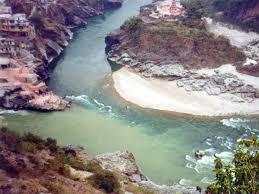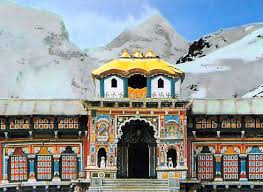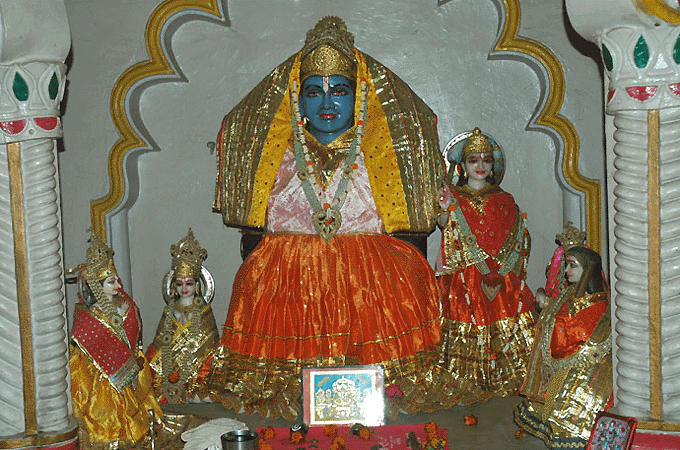alaknanda river in badrinath:
Badrinath is mentioned in religious texts as far back as the Vedic period.
One legend explains the reason that Vishnu is shown sitting in padmasana
http://www.hoparoundindia.com/state-guides/uttarakhand.aspx, rather than reclining. According to the story, Vishnu was chastised by a sage who saw Vishnu's consort Lakshmi massaging his feet. Vishnu went to Badrinath to perform austerity, meditating for a long time in padmasana. To this day, the area around Badrinath attracts yogis who come for meditation and seclusion.
One more logical Legend explains both name itself and sitting posture as this place was full of Badri (Bael Fruit,'Ber' in Hindi) bushes and Vishnu
http://www.hoparoundindia.com/uttarakhand/city-guides/badrinath.aspx meditating for couple of hundred years,beloved Lakshmi stood next to him sheltering him from scorching sunlight turned into a Badri herself called 'BADRI VISHAL' and her lord(Nath) became the BadriNath.
Another legend says that Shiva and Parvati were doing tapas in Badrinath. Vishnu came in disguise as a small boy, crying loudly and disturbing them. Parvati asked the reason for his crying and he replied that he wanted Badrinath for meditation. Shiva and Parvati found that it was Lord Narayan in disguise. They then left Badrinath and moved to Kedarnath.
According to the Bhagavata Purana, "There in Badrikashram the Personality of Godhead (Vishnu), in his incarnation as the sages Nara and Narayana, had been undergoing great penance since time immemorial for the welfare of all living entities." The Skanda Purana states that
http://www.hoparoundindia.com/uttarakhand/attractions/badrinath.aspx “There are several sacred shrines in heaven, on earth, and in hell; but there is no shrine like Badrinath.” The area around Badrinath was also celebrated in Padma Purana as abounding in spiritual treasures.
This temple is char dham place. Dhanu, Simha and Mesh Rashi person should visit once in life here. ( ref: om guru om book)

The Badrinath temple is one of five related shrines called Panch Badri that are dedicated to worship of Lord Vishnu.
Vishal Badri: Badrinath Temple in Badrinath.
Yogadhyan Badri: located at Pandukeshwar. It also has an image of Badrinath in meditative posture. Legend has it that King Pandu installed a statue here named Yogadhyan Badri.
Bhavishya Badri: 17 km (10.6 mi) from Jyotirmath at Subain. Legend says that when evil is on the rise in the world, Badrinath will become inaccessible and Lord Badrinath will appear at the Bhavishya Badri temple. Thus it is the future, or Bhavishya Badri.
Vridh Badri: 7 km (4.3 mi) from Jyotirmath in Animath. Vridh Badri means 'Old Badri.' Legend says this is where the Badrinath image was originally worshipped, before being enshrined at the current Badrinath.
Adi Badri: 17 km (10.6 mi) from Karnaprayag. A temple complex consisting of sixteen small temples with intricate carvings houses a three foot black stone statue of Lord Vishnu

Specials:
1. This temple is opened only six months in a year, from mid of May to the third week of November. But, it depends only upon the temple authorities. The temple is closed for next six months due to heavy snow-fall in winter.
2. The Lord God known in Tamil as Perumal is transformed from this temple to Joshi mutt temple for that six months when the Badrinath temple is closed. And after 6 months, he is taken back to Badrinath temple itself.
Sthalapuranam
The Perumal serves as a “Teacher” (Guru) for himself and thereby explaining the Gnana to the world in 5 different ways.
The characters of (Soul) Aathma.Character of ( Soul) Paramathma.What the Aathma has to attain.The ways, to attain it andThe obstacles that are found for the Aathma while its attaining it.
The Perumal, Badrin Narayana explains all these 5 different things known as “Artha Panjaga Gnanam”. For a human, 5 relations are the most prominent one. They are Mother, Father, Guru, God and the pre generation persons known as Pithru. In this, Guru is so important and it is non – equivalent to anything. Without a proper guidance from a Guru, one cannot attain anything. So, the perumal here serves as the guru and explain the Wisdom – Gnana to the world.
As the same way, the perumal is born as both Naran and Narayanan and he gives the seva to both Naran and Narayanan and he gives the seva to Naran thereby explaining the Gnanam towards him.
While going towards Badrinath, one can enjoy the visit and get the seva of Perumals in Haridwar, VishnupAdham, Thiriveni Sangamam, Rishikesh, Deva Prayag, Kandam (Kadinagar), Rudra Prayag, Karna Prayag, Nandha Prayag, Joshi mutt, Hanuman Chatti, Bramagha dam, Taptha Kundam and Simha Dwaram.
Badrinath is 10,380 feet above from the sea level. Bhaktas who travel Badrinath, first should visit Brahma Kundam (theertham) in Haridwar, where bhaktas take a spiritual bath in that theertham before going to Badrinath. This place is also called as “Vishnu PAdhm” (Foot prints of Sri Maha Vishnu).
From here, we can see the Ganga river originating. It is said that river Ganga originates from the thiruvadi (feet) of Sri Vishnu. The Dwaram (the small entrance (or) hole) from where the Ganga river originates is said to be Haridwar. People get this Ganga water in a closed vessel containers and take to their homes and keep them as sacred. Haridwar is called as “Kapilasthan”, because Kapila Munivar did the tapas here and worshipped Goddess Maya and because of this, the place is also called as “Mayapuri”. There are temples for Goddess Manasa Devi, Chandi Devi, Maya Devi, Anjani Devi, Neeleshwar, Dattatreya, Navagrahas, Mahadeva and Mrithyunjaya Mahadeva.http://www.hoparoundindia.com/about-uttarakhand.aspx

Thiruvadhari Ashramam - Sri Badri Narayana Perumal Temple, Badrinath
Lots of Ashrams are found. Some of them are Kailasha Ashram dedicated to Aadhi Sankarar, Sri Vananda Ashram started by Swami Sivanandar, Gita Ashram, Swarga Ashram, Paramathma Niketan.
Badrinath is said to be one among the great Dhamas (holy Shrines). Other great Dhamas are Rameswaram, Dwaraka and Jagannath. There are 5 Badris namely Vishal Badri, Dhayana Badri, Yoga Badri, Vridha Badri and Bhavishya Badri and five prayags are Devaprayag, Rudra prayag, Karnaprayag, Nandaprayag and Vishnu prayag.
Devaprayag:
This is the place where the Alaknanda and Bagirthi rivers mingle to one another and the river falls down as “Aadhi Ganga”, In Devaprayag, Brahma deva, King Dasaratha and Sri Rama are believed to have done tapas. And a Mutt is installed by Aadhi Sankara here.
Rudraprayag:
Rudraprayag is the place where river Mandakini joins the Alankananda river. Here a temple for Rudra is situated. Mandakini river rises from Kedarnath and it joins Ganga and then towards Madhya Maheshwar near Gupta Kasi. In Gupta Kasi a famous temple for Ardha Nareeshwarar (half of the body portion representing the Power known as Shakti – Uma and other half as Shiva).
Karnaprayag:
Karnaprayag is the place where Karnan did strong tapas to get all sorts of mantra arrows.
Nandaprayag:
Nandaprayag is the place where the Nandakini river arises and joins Alaknanda. It is said that king Nanda did a severe tapas here in this place.
Vishnuprayag:
It is believed that this is the place where Pandu King did strong tapas towards the Emperumaan Sri Vishnu and it is believed to be the birth place of Panja Pandavas.
Next to Vishnu Prayag is a place called Hanuman Ghat where Lord Hanuman and Bheema met each other. Once, Bheema thought he was the strong person in the world and was traveling along this side. At that time, Hanuman laid there as an old monkey. Bheema say an old monkey lying before him in the path and shouted at the monkey to give way for him. But, the old monkey (Hanuman) told that since he is so weak, he unable to move and requested that if Bheema could move the tail, he can move it and go along with his way. Bheema, not knowing that the Monkey is none other than the so powerful Hanuman, thought he can move the tail with his one hand, but he could not do so. Using his full strength, he tried, but he could not even move the tail for an inch. Finally, he thought, the old monkey might be some Demon known as Arakkan (or) Magician. But finally, Anjaneya revealed his original posture (Roopam) and explains him that they are brothers (since both them are sons of Lord Air known as Vaayu). Bheema fell to the feet of Sri Anjaneya and asked that he should be along with them during the war against the Gauravas (Duriyodhanan and his troop). Sri Anjaneya told that he will be along with them in the flag which is on top of the Chariot of Arjuna.
Since, Naran and Narayanan came to this sthalam, two mountains on the names of them are found. The Nara Parvatham (mountain) is on the Eastern bank of Alknanda river and Narayana parvatham on the west bank of Alknanda river. These two mountains are almost covered by snow, in all times.
Nara Parvatham is also called as Kubera Bhandar since lots of precious gems and diamonds are found on its glaciers. Once, there lived an arakkan (demon) by name “Sahasrakavacha”, who gave lots of trouble for the Rishis and yogis. All of them prayed towards the perumal to save them out from the Demon. At that time, both Naran and Narayanan did tapas towards the perumal. On hearing that these two persons were doing severe tapas towards the Emperumaan, Sahasrakavachan rushed towards them to kill them. Both, Naran and Narayanan fought strongly with the demon and finally killed him. Thus, they permanently stayed in Badrinath to save all the Rishis and Yogis from all the demons.
About 5 miles away from Badrinath, is a place known as “Dharma Shila”. It is believed that in this place, Dharma Rajan and his wife Kala did tapas towards the Lord Sri MahaVishnu. As a boon from the Lord, Dharma Raja and his wife asked that the Lord should also be along with them and that’s the reason why Dharma shila is found near Badrinath.
Tapta Kund:
This tapta Kund situated in between the temple (Badrinarayanan) and Alaknanda river. Despite being so cold and lots of snow falls, this tapta kund excretes hot water (springs) which is said to be a special one. It is said that the Ganga river after coming from the Divine Feet of Sriman Narayana is beared by the Lord Shivaperuman’s head and since it comes out form the hot and from Kabhala of Shiva, it is said the water of Tapta kund is hotter.
After taking bath in tapta kund, devotees to climb some steps upwards to worship Garudalwar. After worshipping him, we can reach the pragaram. The place is known as ‘Simh Dwaram’ where Garudalwar statue is situated..
In front of Badrinath temple, the Nara and Narayanan mountain are located. Inside the temple, Lord Sri Badrinarayana in sitting position which is termed as “Padmasana” pose. On his left is Naran and Narayana and to his right, Kubera with his face adorned in silver. Narada Maharishi is also there along with them. A Sudharsana Chakkaram (A power of Wheel in Lord’s right hand) to spiritualise the kshetram. The Utsavar is Uddhava and in front of him is a small Garudalwar statue.
It is said that a big date tree (Elandhai) is covering the Badrinarayana temple and it will not be visible to any person in Kali yugha. The tree is said to symbolize Sri Mahalakshmi and she is protecting Badrinarayana from cold by covering him.
Moolavar and his Sannadhi:

The Moolavar Badrinarayana is said to be made of Salagramam. He is along with Aravindhavalli thaayar, Garuda, Kubera, Naradha, Utthavar, Devarishi and Narayana. He is in sitting pose and has 4 hands. His left hand holds the Sangu the Conch and in his right hand hold the Wheel the chakkaram and lifted upwards and remaining two hands are joined together and found as Yoga mudra and Abhaya Varadhan.
Devotees can get the darshan of this Lord,
http://www.hoparoundindia.com/uttarakhand/badrinath-attractions/badrinath-temple.aspx without any time restriction they can spend here and Holy bath to Lord known as Thirumanjanam, offering of eatables etc are done in the presence of the devotees.
Thaayar and her Sannadhi:http://www.hoparoundindia.com/state-guides/uttarakhand.aspx
On the south pragharam of the temple is the sannadhi for Aravindhavalli thaayar is situated and She is called as “Mahalakshmi”. On the west side, Aadhi sankara sannadhi and behind the temple, Lakshmi Narasimha Mandir and Sannadhis for Sri Swami Desikar, Udayavar Ramanujar are located.
On the north side of the temple on the bank of River Ganges, a big rock named “Brahma Gobalam”; it is believed that if we dedicate Pindam (a ball made of rice) here for the departed souls known as Pithrus, for the next 14 generations people are said to go to heaven and Moksha. And if done once, thereafter, if one perform this once, there is no need to do the annual ritual for the departed souls that is known as Shrardham.
Moolavar:
The Moolavar of Badrinath Kshetram is Badri Narayanan. He is in sitting posture (Irundha thirukkolam) facing east Prathyaksham for Naran.
Thaayar:
The Thaayar in this Kshetram is Aravindhavalli.
Mangalasasanam:
Periyalwar – 1 Paasuram.
Thirumangai Alwar – 21 Paasurams
Pushkarani:
Tapta Kundam.
Sthala Viruksham (Tree):
Badri Viruksham (Date tree).
Vimaanam:
Tapta Kanjana Vimaanam.
TO KNOW MORE www.hoparoundindia.com

